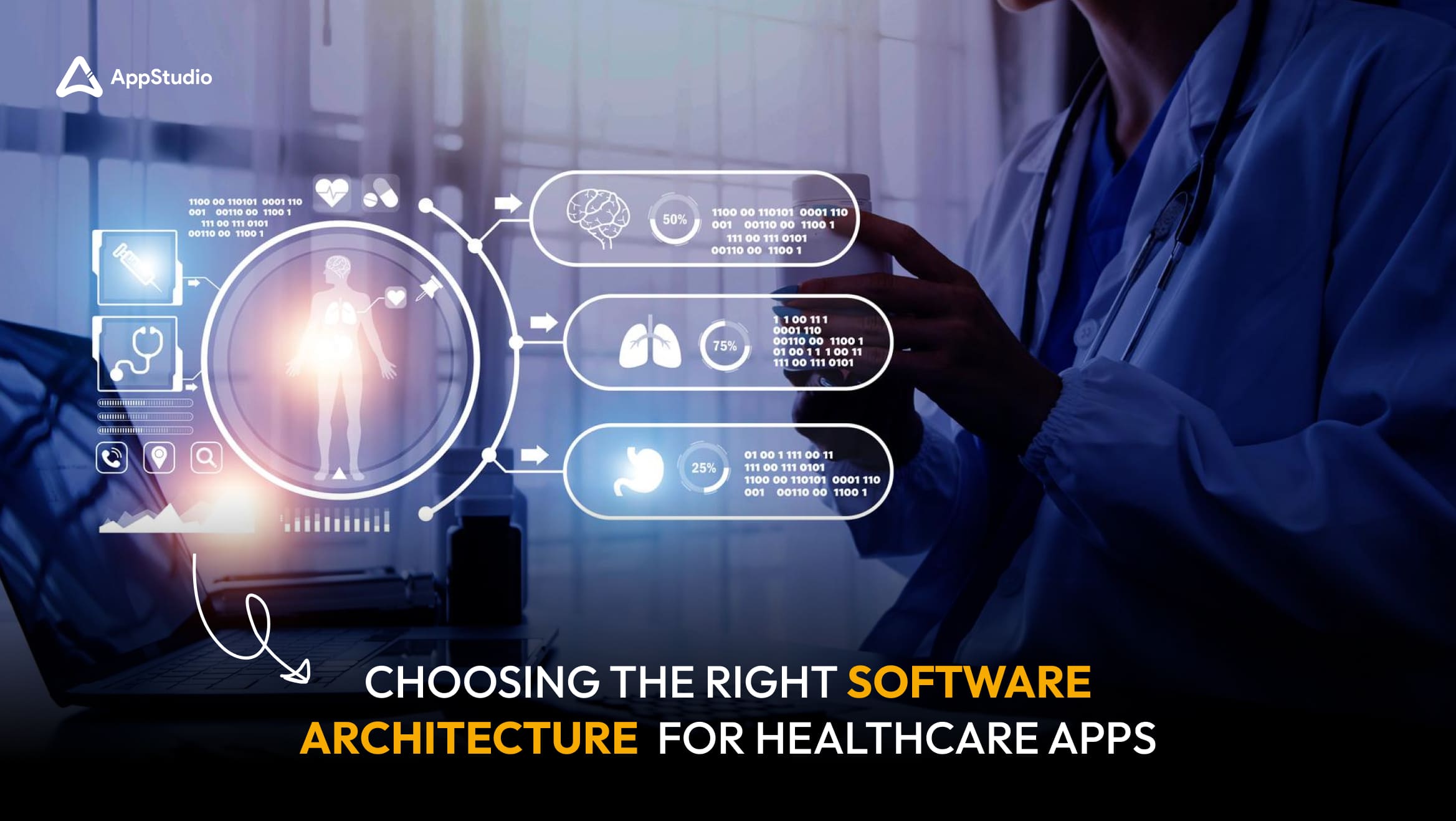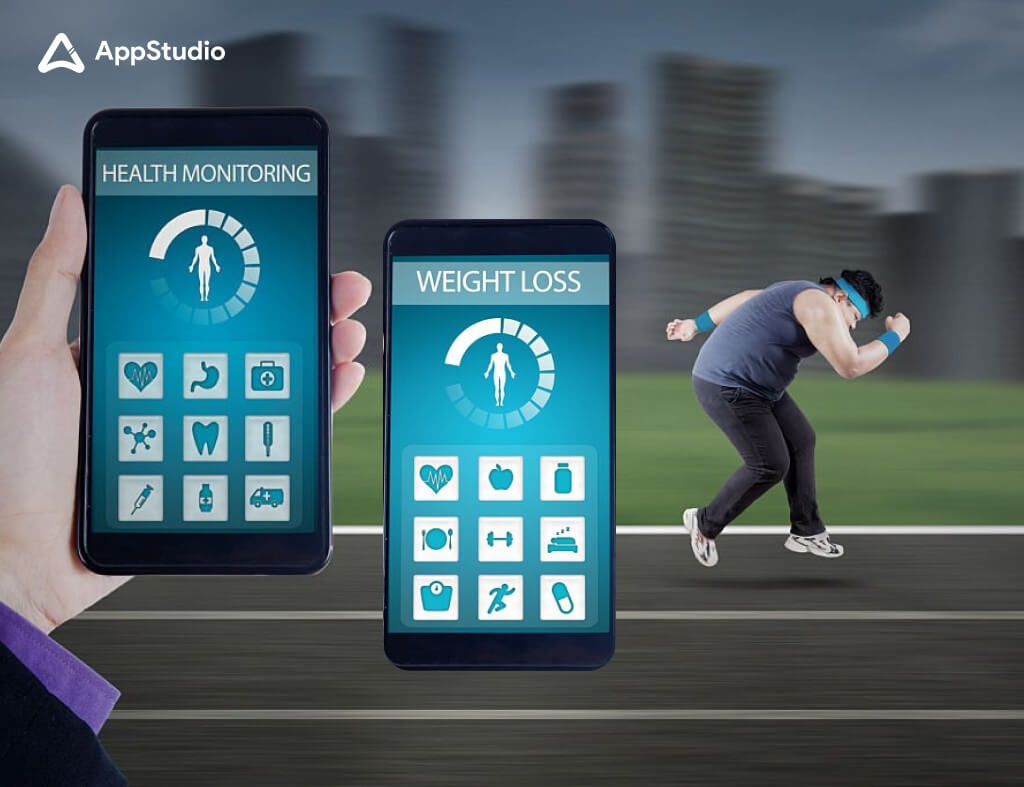As healthcare technology continues to advance, software development in the healthcare sector is rapidly transforming. Today, apps that facilitate remote consultations or monitor health conditions in real time are becoming essential tools in healthcare delivery. This shift underscores the critical need for robust software architecture.
Effective software architecture improves functionality and user experience and ensures the security and privacy of sensitive health information. It enables efficient real-time data processing and smooth communication between various healthcare systems.
This supports quick medical decisions and facilitates a collaborative approach to patient care, proving that well-thought-out software architecture is vital for enhancing healthcare technology trends and patient outcomes. In this blog, we’ll discuss how to select the right architecture for healthcare apps, as well as the various stages of development and their specific architectural needs. So, let’s get started.
How to Select the Right Software Architecture for Healthcare Apps?
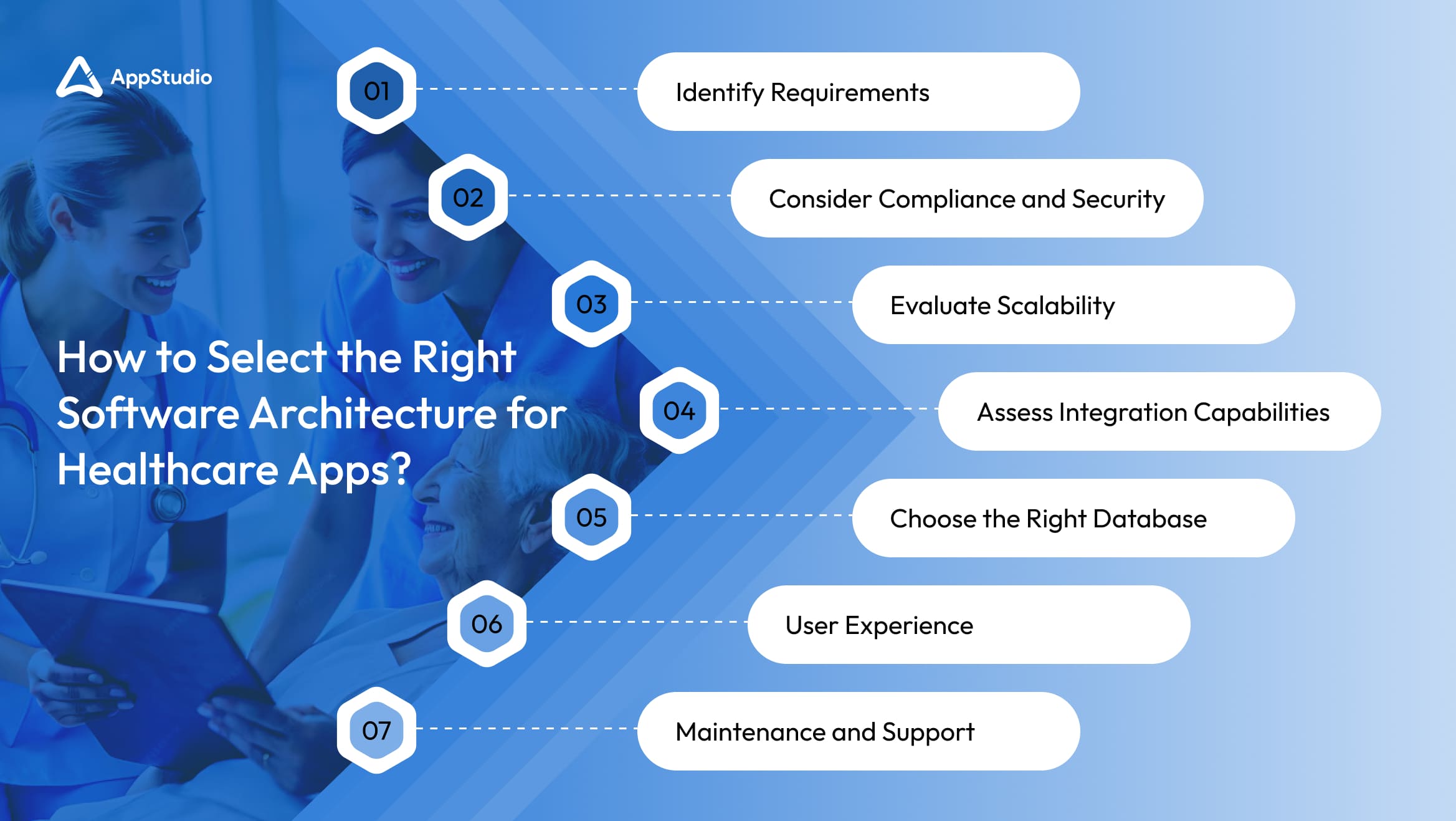
Selecting the right software architecture for healthcare apps is crucial because it affects everything from the security of patient data to the app’s performance and scalability. Here are some simple steps to help choose the appropriate architecture:
1. Identify Requirements
Before deciding on an architecture, clearly define what the healthcare app needs to do. For example, does it need to handle real-time health monitoring, or is it for managing patient records? Knowing the specific requirements will guide the architecture choice.
2. Consider Compliance and Security
Healthcare apps must comply with regulations like HIPAA in the U.S., which protects patient data privacy. Choose an architecture that supports strong security measures to protect data. For instance, using a microservices architecture can isolate services, reducing the risk of widespread data breaches.
3. Evaluate Scalability
The architecture should support scaling, especially if the app will serve a large number of users or handle large volumes of data. For example, a cloud-based solution can be a good choice because it allows you to scale resources up or down based on demand.
4. Assess Integration Capabilities
Healthcare apps often need to integrate with other systems like hospital records management or insurance databases. Consider architectures that facilitate easy integration. Service-oriented architecture (SOA) can be effective, as it allows different services to communicate with each other through a well-defined interface.
5. Choose the Right Database
The choice of database is critical in healthcare applications for managing vast amounts of data efficiently. For instance, a NoSQL database might be better for handling unstructured data such as patient notes, while a relational database could be ideal for structured data like medical records.
6. User Experience
Ensure the architecture supports a responsive and intuitive user interface. Apps that are easy to navigate and quick to respond improve user satisfaction. For example, using a client-server architecture can help manage the workload between the server and the client side, leading to faster user interactions.
7. Maintenance and Support
Opt for an architecture that is easy to maintain and update. This consideration will help keep the app current with the latest security patches and functional improvements.
Related reading : Healthcare Mobile App Development: Blueprint For Startups & SMEs
Stages and Architectural Needs of a Healthcare Software
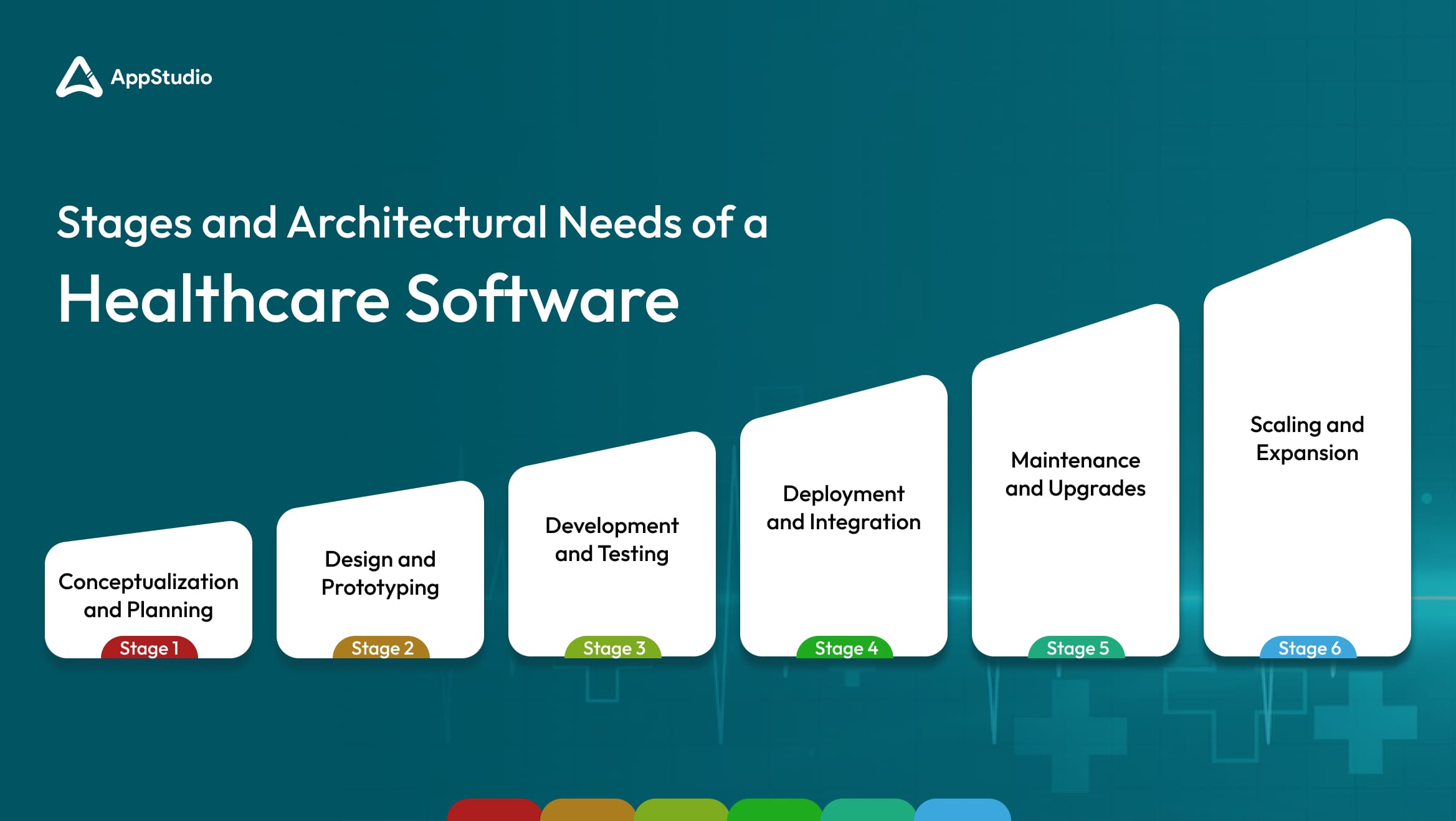
Developing healthcare software involves several distinct stages, each with its own set of architectural needs. Understanding these stages and the corresponding requirements can help in designing systems that are robust, scalable, and compliant. Here’s a breakdown of the various stages and their specific architectural needs:
1. Conceptualization and Planning
In the initial stage, it’s crucial to conduct a comprehensive requirement analysis to understand the software’s objectives, target users, compliance requirements, and specific healthcare needs. Selecting the right technology stack is equally important, including decisions on programming languages, database systems, and cloud services.
Example: For a telemedicine platform, architects might choose secure WebRTC technology for real-time communication, because WebRTC complies with HIPAA regulations for patient data security.
2. Design and Prototyping
A modular architecture is essential to allow individual components or modules to be developed, tested, and scaled independently. Early prototype development helps test ideas and gather user feedback, which is critical for iterative design improvements.
Example: In designing an EHR system, a prototype might include modules for patient registration, appointment scheduling, and medical records management to evaluate user interaction and module interoperability.
3. Development and Testing
Developing a scalable architecture makes sure the system can handle increased loads, which may involve utilizing cloud solutions that adjust resources based on demand. Security implementations must include strong protocols like encryption and secure authentication mechanisms. Comprehensive testing, including unit, integration, and compliance testing, guarantees the software meets all functional and regulatory requirements.
Example: A patient monitoring system using a microservices architecture would allow functionalities like data collection, analysis, and alerting to scale independently as the number of monitored patients increases.
4. Deployment and Integration
Deployment automation tools are used to reduce human errors and standardize environments. It’s also crucial that new software integrates smoothly with existing healthcare IT systems, such as hospital management systems and diagnostic tools.
Example: Consider a healthcare app that needs to interface with an existing Electronic Health Record (EHR) system. Adopting a service-oriented architecture (SOA) could be advantageous as it allows the app to communicate with the EHR through a set of defined services and interfaces.
5. Maintenance and Upgrades
Ongoing software monitoring is necessary to track performance and preemptively identify issues. The system should be designed for easy upgradability, allowing updates to be implemented with minimal service disruption.
Example: If a healthcare analytics app uses a microservices architecture, new data visualization tools can be added or updated independently. This means upgrades don’t interrupt ongoing analyses, demonstrating how the system’s design minimizes downtime while enhancing functionality.
6. Scaling and Expansion
Architectures should support dynamic resource allocation, facilitated by cloud environments, and employ data management strategies such as database sharding or using NoSQL databases for unstructured data to maintain performance under increased loads.
Example: A cloud-based healthcare app development might use the auto-scaling features of AWS or Azure to manage varying loads effectively during epidemic outbreaks, adjusting resources to meet the sudden high demand.
Related reading : How is IoMT Revolutionizing the Healthcare Industry?
Architectural Strategies for Product Phase
In this section, we will discuss how to plan the architecture from the early development stages to full-scale operations, covering crucial phases such as MVP, growth, scaling, and ensuring security and compliance.
Architecture for Healthcare MVP
Initial MVP Phase: In the MVP development phase, the focus is on creating a minimal setup that covers only the most essential features to validate the core idea. This phase is about speed and cost-efficiency, employing a straightforward architecture that supports quick iterations based on user feedback.
For example, a telehealth app in its MVP stage might only feature video calls and appointment scheduling to validate the user acceptance without advanced features like prescription management or integration with EHRs.
Alpha Release: The alpha release is a critical step where the initial functional prototype of the software is exposed to a limited group of users, usually internal testers or selected external experts. The goal here is to identify and fix any critical bugs or issues before wider exposure.
For the telehealth app, an alpha release might involve testing the core video conferencing functionality with real network conditions to ensure stability and performance.
Beta Release: Following the alpha, the beta release is a more polished version of the software made available to a broader audience. This phase is crucial for understanding how the software performs in real-world scenarios and collects extensive feedback.
For example, extending the telehealth app beta version to a larger group, including potential patients, to test usability and gather feedback on additional features like the user interface and appointment booking process.
Healthcare Software Architecture for Growth Stage
As the software moves from MVP to full product development, the architecture needs to support more extensive user needs and more complex workflows.
For instance, the telehealth app may need to integrate laboratory systems for tests and EHRs for comprehensive patient records management.
Key Architectural Characteristics for Growth:
- Loosely Coupled Systems: This ensures that different components like billing, patient data, and scheduling can be developed and updated independently.
- High Cohesion: Ensures that all parts of the system related to a specific feature work closely and efficiently.
- Modularity: Facilitates the easy addition of new features such as e-prescriptions or multi-party video calls without extensive overhauls.
Healthcare Software Architecture for Scale
When scaling the software, architectural considerations include handling increased loads and ensuring consistent performance across all user interactions.
For a national roll-out of the telehealth app, considerations might include deploying across multiple data centers to reduce latency and employing load balancers to manage user traffic efficiently.
Security and Compliance Architecture for Healthcare Software
Security and compliance are paramount in healthcare applications due to sensitive health data. For instance, using HIPAA-compliant cloud services helps ensure that data is encrypted both at rest and in transit, while secure access controls protect patient information.
Additionally, utilizing AWS tools like Amazon Cognito for user authentication and AWS KMS for key management can help align with HIPAA standards and ensure data integrity and security. This also maintains the confidentiality and safety of healthcare data.
Related reading : Top 8 Virtual Healthcare Apps Revolutionizing the Healthcare Sector
Top 7 Key Factors that Impact Healthcare Software Architecture
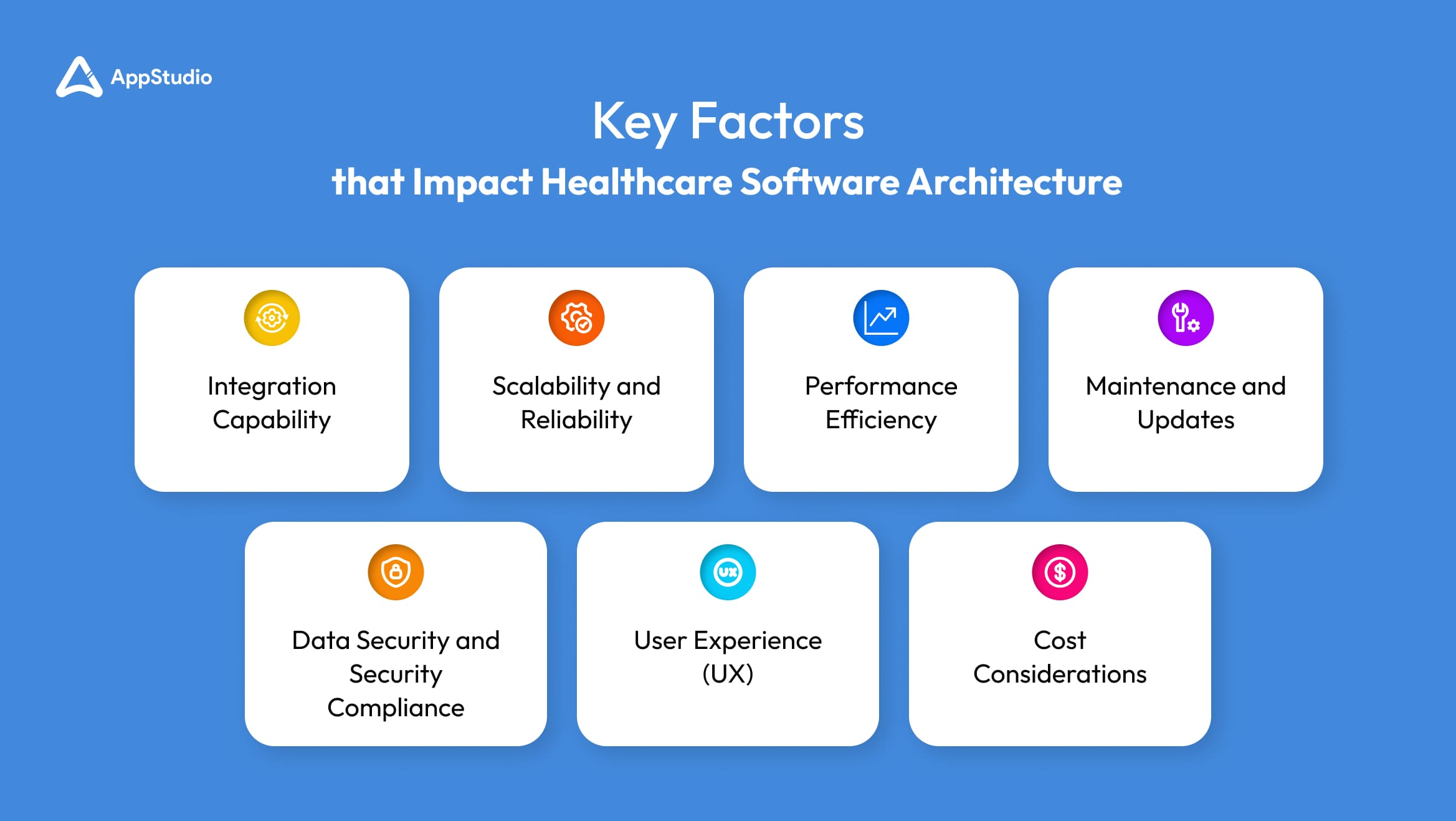
Several key factors impact the architecture of healthcare software. They influence how the systems are designed, implemented, and maintained. Here’s a detailed look at the primary factors that shape healthcare software architecture:
1. Data Security and Security Compliance
Protecting patient data is paramount in healthcare software. The architecture must incorporate advanced security measures such as end-to-end encryption, secure data transmission methods, and robust access control mechanisms. These features help prevent unauthorized access, data breaches, and leaks. Security strategies must be proactive, involving regular security audits, penetration testing, and adherence to best practices in cybersecurity.
Healthcare applications must also comply with stringent regulatory standards that govern the privacy, security, and accessibility of patient data. For instance, in the United States, software must adhere to HIPAA (Health Insurance Portability and Accountability Act) standards, which protect patient health information. Similarly, in Europe, GDPR (General Data Protection Regulation) imposes strict rules on data protection and privacy.
2. Integration Capability
Healthcare systems often need to integrate with various other systems such as electronic health records (EHRs), lab information systems (LIS), pharmacy management systems, and third-party applications. Effective integration enhances interoperability, facilitating seamless communication and data exchange across platforms. This requires the architecture to support standard data exchange protocols like HL7, FHIR, and others, ensuring that systems can communicate efficiently without losing data integrity.
3. Scalability and Reliability
Healthcare systems must handle varying loads efficiently, particularly during peak usage times, without compromising performance. Architectures need to be scalable, often using cloud-based solutions to allow for easy scaling up or down based on demand. Reliability is also crucial; the system must be fault-tolerant and capable of recovering quickly from hardware or software failures for continuous availability.
4. User Experience (UX)
Healthcare software must be intuitive and easy to use for a diverse user base, including medical professionals, administrative staff, and patients. This involves designing interfaces that are accessible to users with different levels of technical expertise and physical abilities. The architecture should support responsive design, ensuring that applications are accessible on various devices like tablets, smartphones, and desktops.
5. Performance Efficiency
The architecture must ensure that the software performs tasks within an acceptable time frame to not hinder medical processes. This involves optimizing databases, implementing efficient data caching strategies, and minimizing latency in data retrieval and display.
6. Maintenance and Updates
Given the rapid pace of technological advances and changes in medical protocols, healthcare software must be easy to update and maintain. Architectural decisions should therefore favor modular designs that allow for individual components of the software to be updated without affecting the entire system.
7. Cost Considerations
Finally, the cost of development, deployment, and maintenance must be considered. Effective software architecture optimizes the use of resources, reducing costs while maintaining quality and compliance. Cloud solutions, for instance, can reduce the need for expensive hardware and dedicated IT maintenance staff.
Related reading : An Insightful Guide to Telemedicine App Development
Final Words!
Healthcare software development involves carefully planning the architecture to support all stages of a product’s life. From starting with a basic MVP to expanding for widespread use, each step needs close attention to security, compliance, functionality, and user experience. Good planning ensures that healthcare apps not only meet high standards but also work well as technology changes and can deliver excellent care efficiently and securely.At Appstudio, we specialize in creating healthcare software architectures that fit the unique needs of each business. Our team uses the latest technologies and best practices to build strong, scalable, and compliant systems. So, contact us today!
Frequently Asked Questions
Software architecture is crucial in healthcare to ensure applications are secure, efficient, and capable of handling sensitive health data while supporting seamless interactions across various healthcare systems.
Appstudio adheres to stringent industry standards, including HIPAA in the U.S. and GDPR in Europe, by incorporating compliance into the architecture from the ground up with secure data handling, encryption, and audit trails.
An MVP, or Minimum Viable Product, in healthcare software development refers to the initial version of an application with just enough features to attract early adopters and validate a product idea early in the development cycle.
Appstudio designs scalable architectures using cloud solutions and microservices, enabling healthcare systems to handle increased loads and expand functionality without disruption.
A user-friendly healthcare software offers intuitive interfaces, clear navigation, and accessibility features to accommodate users of all technical abilities. This helps medical professionals and patients in using the software effectively.
Yes, Appstudio specializes in integrating existing healthcare systems with new applications, ensuring seamless data flow and functionality across platforms using industry-standard protocols like HL7 and FHIR.
